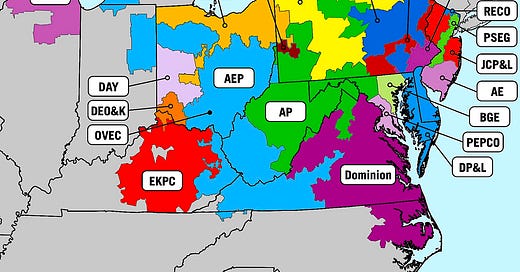PJM Battery Storage Would Cost A Total of $2.4 Trillion, Which Isn't Feasible and Needs to Be Disgarded As A Very Bad Idea
Guest Post from David Wojick via CFact.
I keep reading how big batteries are all it takes to make wind and solar reliable as the sole grid electricity source. The reality is that making wind and solar work at all requires a fantastic amount of battery backup, far more than is possible.
Below is an example using the PJM grid. PJM is America’s biggest grid operator, with a territory covering the Mid-Atlantic and points west. Their territory includes the Washington, DC metro area, where all the federal bigwigs live, making it a good place to start. I also live there.
We are quantifying a fantasy, so let’s keep it very simple. In fact, the basic question is why hasn’t PJM done this simple analysis? They do a lot of sophisticated grid modeling. Or maybe they have done this crucial assessment, but it is a secret, which is even worse.
Consider a single day in a typical peak demand summer heatwave. The heatwave is due to a stagnant high-pressure system called a Bermuda high, so there is not enough wind to generate usable wind power, no matter how much generating capacity is available.
It is sunny during the day, so let’s assume that for 8 hours we get enough solar to meet demand (or, as I prefer to call it, to meet need). For the other 16 hours, we meet demand using batteries. We import nothing because our neighbors are in the same needy boat.
Finally, for simplicity, I assume the demand is at the peak level for the entire 24 hour day. This overestimates things a bit, but we will find that does not matter. A fancier analysis would use a typical demand curve. PJM can handle that.
My example year is 2030, as that is a standard near-term transition target year for which we have reasonable estimates of peak demand. Here then are the very simple numbers.
PJM’s estimate peak demand for 2030 is about 180,000 MW.
Meeting that for 16 hours with batteries requires 2,880,000 MWh of usable storage.
Usable storage is between 20% and 80% of nameplate battery capacity, hence 60%.
Thus we need 4,800,000 MWh of nameplate battery capacity.
Storage facility capital costs vary, but $500,000 per MWh is a reasonable estimate.
This gives a total cost of $2.4 trillion, or $2,400,000,000,000, for the batteries to make wind and solar reliable in this case. This fantastic cost is clearly not feasible.
There are things that could make this number go down a bit, such as reduced cost per MWh. But given last year saw just 130,000 MWh installed worldwide, the production capacity does not exist, so we are talking about new mines and factories. It actually cannot be done by 2030, not even close.
But the realistic numbers would be much higher if this fantasy played out because low wind, near-peak heatwaves often last for several days, even a week. Ten trillion dollars is easily possible. We are, after all, talking about hundreds of thousands of tractor-trailer sized batteries, basically containers full of expensive chemicals. Moreover, this is just for PJM.
Batteries simply cannot make a transition to wind and solar power feasible. The amount, and hence the cost, of storage is far too great.
Given the simplicity of this analysis, using readily available data, the big question is why are these impossible numbers not already widely known? PJM and their big utilities all do detailed modeling and supposed reliability assessments. So does NERC, whose sole mission is reliability. Many utilities file annual Integrated Resource Plans with their state regulators, typically looking out 20 years or more.
That battery backup cannot make wind and solar powered grids possible is obvious given these incredible numbers. The electric power industry must know this, but their silence is deafening.
Dr. David Wojick is an independent policy analyst and senior advisor to CFACT. As a civil engineer with a Ph.D. in logic and analytic philosophy of science, he brings a unique perspective to complex policy issues. His specializes in science and technology intensive issues, especially in energy and environment.
#Grid #Storage #GridStorage #Batteries #BatteryStorage #Electricity #PJM





The promoters of the battery and wind and solar should make the investment. And any consumer should have the choice to participate in using their produced electricity. Of course all would fail economically immediately. That sums up the entire wind/solar/battery efforts. It’s delusional and pushed by grifters as hoax promoters. The public will not be hoodwinked when costs are truthfully and fully exposed at the concept stage of the projects. Facts haven’t changed the narrative of the great grift; only rejection by the public will return society to sanity.
Thanks for the easy-to-understand example. Fortunately, the President's energy secretary, Chris Wright, knows these facts, and is doing everything he can to correct energy policy. We can't rely on the utilities to do it as long as they can profit from the subsidized policies of the former administration.